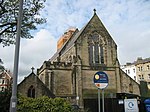The Athletic Ground, latterly known as the McCain Stadium, was a football stadium located on Seamer Road in Scarborough, North Yorkshire, England. It was the home of Scarborough F.C., a defunct football club who last played in the English Conference North before they were dissolved on 20 June 2007 with debts of £2.5 million.The stadium hosted league football from 1987, when the club won promotion to the Football League, until relegation in 1999. Although Scarborough’s 12 seasons in the league were all spent in the fourth tier, the stadium hosted several cup ties against teams from the top two divisions. The first league match hosted Wolverhampton Wanderers.
The venue was first opened in 1898, when Scarborough F.C. moved from playing at Scarborough Cricket Club. In 1988, under a sponsorship deal, the club sold the naming rights of the Athletic Ground to McCain Foods and, until its closure in 2007, the stadium was known as the McCain Stadium. Due to the sponsor, the ground was nicknamed the "Theatre of Chips".The ground was the venue for twenty-four Scarborough fixtures, that had in excess of 6,000 spectators. The biggest attendance was in January 1938, vs Luton Town in the FA Cup, the crowd recorded was 11,162.
The stadium hosted games between Scarborough FC and illustrious names such as Arsenal, Chelsea (twice), Portsmouth, Southampton (twice), Bolton Wanderers, Fulham,
Middlesbrough, Coventry City, Crystal Palace, Brighton and Hove Albion & Bradford City in cup ties, whilst also hosting a series of league clashes with Yorkshire rivals York City and Hull City more often in league fixtures. Scarborough's first game in the Football League vs Wolverhampton Wanderers, attended by a crowd of 7,314 on 15 August 1987, was marred by crowd trouble.Scarborough played Red Star Belgrade in a friendly at the stadium in July 1990, which Red Star won 4–2. Red Star subsequently won the European Cup the following season.
The arena had dual usage in the 1991–92, when the Scarborough Pirates (Rugby League) played at the ground, only four games had crowds in excess of 1,000. Baseball was another sport played at the ground for a single season in 1936, the 'Scarborough Seagulls' attracted crowds of up to 1,500 people. The stadium also hosted a floodlit cricket match in September 1980, when a Brian Close XI defeated Scarborough by 26 runs, in front of a 2,000 crowd.
The ground was used briefly for Greyhound racing on Tuesday nights, during the summer months of July & August, in the early 1960's. The course length being 250-285 yards. The first meeting attracted a crowd of 3,500.
Scarborough RUFC played its home games at the stadium, during the club's inaugural season of 1926–27. 1000+ attendances at matches persuaded the club to move away from the ground after just one season to the Old Showground, and ultimately Silver Royd, Scalby. The Rugby club still played the occasional 'Hospital Shield' match at the Athletic Ground and also their 1951 Silver Jubilee game, which attracted a crowd of 1,800.
The stadium became vacant in June 2007 when Scarborough FC went out of business and the new Scarborough Athletic club initially played outside the town. Demolition of the stadium took place four years later.
The gates at the entrance to the ground were preserved.
A Lidl supermarket was built on the site and opened 16 February 2017.










